SVP Server Overview 2-3
SVP Server Installation, Setup, & Maintenance Manual - Revision 1
In a Telephony Gateway environment, the addition of a SVP Server
is detected as soon as the new SVP Server is up and running. The new
SVP Server immediately starts providing the “timing” function for the
appropriate Wireless Telephones. The user should not detect any
change.
If a SVP Server is removed, the removal is detected within one minute.
During this time, any Wireless Telephone that was using the SVP Server
that was removed will be affected in one of the following ways:
• If the Wireless Telephone was not in a call, it may lose contact with its
Telephony Gateway, resulting in a check-out/check-in sequence.
• If the Wireless Telephone was in a call, the audio will be lost and the
call will be dropped.
SVP Server Capacity
The SVP Server requires a CAT 5 cable connection between its network
port and the Ethernet switch. The SVP Server auto-negotiates to the
type of port on the Ethernet switch and supports 10Base-T, 100Base-T,
full-duplex and half-duplex port types.
Table 2-1 lists the maximum
number of calls the SVP Server is able to handle.
Table 2-1 SVP Server Capacity
Multiple SVP Servers can be used in the Telephony Gateway and IP
System environments.
Table 2-2 shows the capacity of Telephony Gateways in a multiple SVP
Server environment.
Supported Calls
Gateways 10Base-T 100Base-T
Number of Wireless
Telephones Supported
IP Gateway 10 80 500
Telephony Gateway 10 120 640

